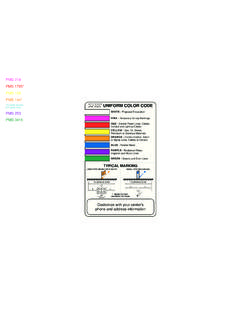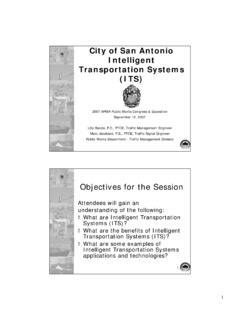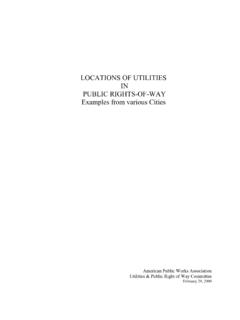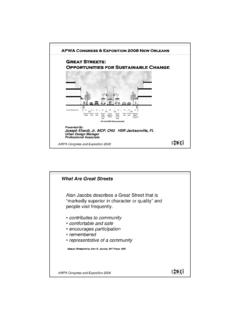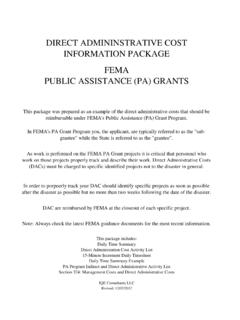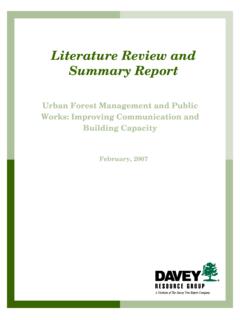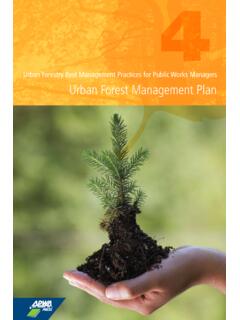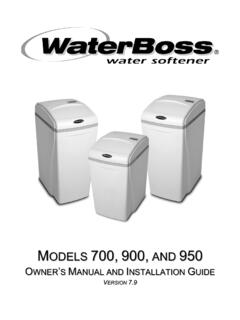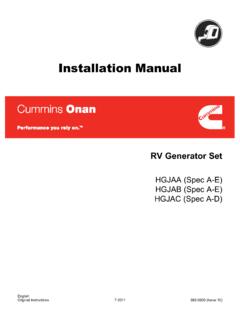Transcription of Recommended Marking Guidelines For Underground Utilities
1 Recommended Marking Guidelines For Underground Utilities FINDINGS OF THE Marking Guidelines SUB-COMMITTEE OF THE APWA ONE-CALL COMMITTEE Michael McDonald, Chair August 9, 2001 Recommended Marking Guidelines for Underground Utilities August 9, 2001 Page i i TABLE OF CONTENTS Marking Guidelines Sub-Committee Appendix A Recommended Marking Appendix B Responses to Comments Appendix C Request for Comments Posted on the Proposed Recommended Marking Guidelines For Underground Utilities Background Why are the Guidelines for Marking Underground facilities needed? The American Public Works Association took the lead in the development of the color codes for the identification of Underground -buried facilities that have been adopted throughout the United States and many other countries. Currently throughout the nation and the world for that matter, the placement and replacement of Underground facilities thrives.
2 The challenges faced by excavators are enormous enough on top of the fact that they must deal with different legislative requirements from different municipalities and states. As a result of this drive to place more and more of our infrastructure Underground , a large number of contractors are crossing both local and state boundaries. At the heart of damage prevention is improved information accuracy and consistency in communication between excavators and operators of Underground facilities. Discussion Because of these issues, One Call Systems International attempted to create Marking Guidelines in the early 90 s. This effort failed however because no stakeholder could reach agreement, and there was no common ground. The Transportation Equity Act for the 21st Century (TEA 21), and the high visibility damages to Underground facilities that lead up to it changed all this.
3 Recommended Marking Guidelines for Underground Utilities August 9, 2001 Page 2 2 Because of this Bill, the Department of Transportation responded to the request for Best Practices relating to damage prevention. These best practices covered everything from the design of a project to the completion and mapping of Underground installations as well as emerging technologies. Membership of the APWA took a lead on this effort and through the relationships built through this process it was agreed that the time was right to move forward with these Guidelines . These proposed Guidelines are not all inclusive, nor with emerging technologies, should anything we propose be. Methodology The process we adopted is as follows: First, make sure that there was accurate representation from all stakeholders as well as support from APWA staff. Our Stake holders represented the following organizations and Trade Associations; American Gas Association, Edison Electrical Institute, the National Telecommunications Damage Prevention Council, One Call Systems International, the National Utility Contractors Association, the AGC, the National Utility Locating Contractors Association (NULCA), Locate Equipment Manufacturers Association, as well as input from the info-now community due to the web posting.
4 There were nine responses from the recommendations posting on the web. Several comments expressed concerns relating to the Marking of no/conflict, or all clear of facilities. Actually this was an oversight by the committee before the posting of the Guidelines on the web and the following changes have been made: If a no conflict exists at the excavation site instead of GAS/OK , a Marking Recommended Marking Guidelines for Underground Utilities August 9, 2001 Page 3 3should be placed indicating at a minimum the initials of the Underground facility owner. Example: NO/PG&E, or a circle with a / through it accompanied by the owners initials. It was also suggested that the company segment be identified as well. As stated in a response from AT&T, Numerous government organizations who have expanded their public works departments and utility units from typical water, sewer, street, and drain operators into power, telephone, cable TV, ISP, and other telecommunications carriers.
5 Finally, there has been a great deal of concern raised about the amount of paint placed on the ground. This was a concern of the committee as well, however of a higher concern was that of Public Safety and the reliability of the nations Underground infrastructure. All responses and comments from this posting have been compiled as well as my responses and are included as appendices. The process for all decisions was based on obtaining consensus of all parties. Everything you see within this proposal are suggested Guidelines that all participants could live with and agreed upon. Many issues still exist that we could not reach agreement on, however it is the committee s feeling that this indeed is a step in the right direction. Marking Guidelines Sub-Committee Members Mike McDonald, Chair American Public Works Association (APWA) Gary McKay Detroit Edison Tim Boatfield Georgia Utility Protection Center Jim Barron National Utility Contractors Association (NUCA) Allen Gray Associated General Contractors of America (AGC) Jacque Washburn 3M Corporation Tom Jackson Georgia Power Morgan Abele National Utility Locating Contractors Association (NULCA) Ron Boes American Gas Association (AGA) Danny Barret National Telecommunication Damage Prevention Council (NTDPC)
6 Dan Simpson WorldCom Bill Kieger Pennsylvania One-Call Recommended Marking Guidelines for Underground Utilities August 9, 2001 Page 4 4 Recommendations We respectfully ask the Board to adopt the following Resolution endorsing the Recommended Marking Guidelines in conjunction with the current Color Codes. Respectfully Submitted by the Marking Guidelines Sub Committee, Michael McDonald, Chair Recommended Marking Guidelines for Underground Utilities August 9, 2001 Page 5 5 Appendix A -- Recommended Marking Guidelines for Underground Utilities Recommended Marking Guidelines for Underground Utilities August 9, 2001 Page 6 6 Recommended Marking Guidelines for Underground Utilities August 9, 2001 Page 7 7 Recommended Marking Guidelines for Underground Utilities August 9, 2001 Page 8 8 Recommended Marking Guidelines for Underground Utilities August 9, 2001 Page 9 9 Recommended Marking Guidelines for Underground Utilities August 9, 2001 Page 10 10 Appendix B Responses to Comments Received Response to Larry Ferguson: Larry the committee agrees totally.
7 Your recommendation will be part of the report delivered to the APWA Board of Directors for approval. Thank you again for taking the time. -----Original Message----- From: Ferguson, Larry D Sent: Friday, June 22, 2001 9:17 PM To: Teresa Hon Cc: Haberkorn, Michael A Subject: Suggestion to showing no gas in area I work for Williams Gas Pipeline and we are in the same areas as local Distribution companies -- In the past we had a real problem with the Local gas company Marking no gas -- but guess what Williams had a high Pressure main 3 feet away. It is imperative that the company Logo or Initials be placed in the locate marks to show which company has no Facility in the area. Response to Dan Munthe: Dan-Thanks for your response. I will respond in the order received. (Line Markings) The premise of arrows at the ends of the requested area makes good sense, however the committee could not reach consensus on a standard or recommendation as to how far apart marks should be based off of variables with field conditions.
8 (Corridor Markings) Even though this has the potential for abuse, this was a compromise reached between the facility owners and the nations two largest Contractor Associations, the , and the National Utility Contractor Association. These marks are to be used when the material, size and number of facilities are not known. (High Pressure) No consensus could be reached on acronyms other than High Pressure. This was partly due to no conflict symbology. It was agreed that any no conflict or site clear indication should include the initials of the company without facilities in the dig area. This could lead to more confusion than currently exists. Recommended Marking Guidelines for Underground Utilities August 9, 2001 Page 11 11( Marking Offsets) If every Underground facility, road or permanent surface ran north to south or east to west, this would be a viable option.
9 ( Marking Buried Splices, Valves, and Manholes) The proposed Guidelines are all the Committee could reach consensus on. (What was not addressed) 1. White Markings: No consensus could be reached due to varied local legislation and whether this should be required on small jobs. 2. Addressed with corridor Marking 3. Addressed with corridor Marking 4. No consensus could be reached 5. No consensus could be reached 6. No consensus could be reached along with magnetic tape -----Original Message----- From: Munthe, Dan Sent: Tuesday, August 21, 2001 12:12 PM To: 'Mike McDonald'; Teresa Hon Subject: RE: Proposed Marking Guidelines Some random thoughts in no particular "Line Markings" Arrows should be used only at the ends of the requested area (as indicated on the one call ticket). This would indicate that the facility continues (of course). "Corridor Markings" This could potentially be abused, if two facilities shared a 10' easement could a locate technician then paint a 10' corridor Marking across the whole easement?
10 "High Pressure" High Pressure. It would be beneficial to develop a standardized list of acronyms for other situations as COM = Communications ELC = Electric STL = Steel EMS = Electronic Marking System device CON = Concrete and etc. " Marking Offsets" direction (N,S,E,and W) should be included. "No Conflict" Should only be used with an informational flag (translucent in color) that Recommended Marking Guidelines for Underground Utilities August 9, 2001 Page 12 12identifies the facility owner and included locate ticket information so that the flag can not be displaced and used elsewhere. " Marking Buried Splices, Valves, and Manholes" Should be differentiation between buried splices and valves and vaults. Also, these standards do not 1. White Markings 2. Size indications (anything over 2" diameter). 3. Material indications (steel, plastic, clay tile, etc.)
